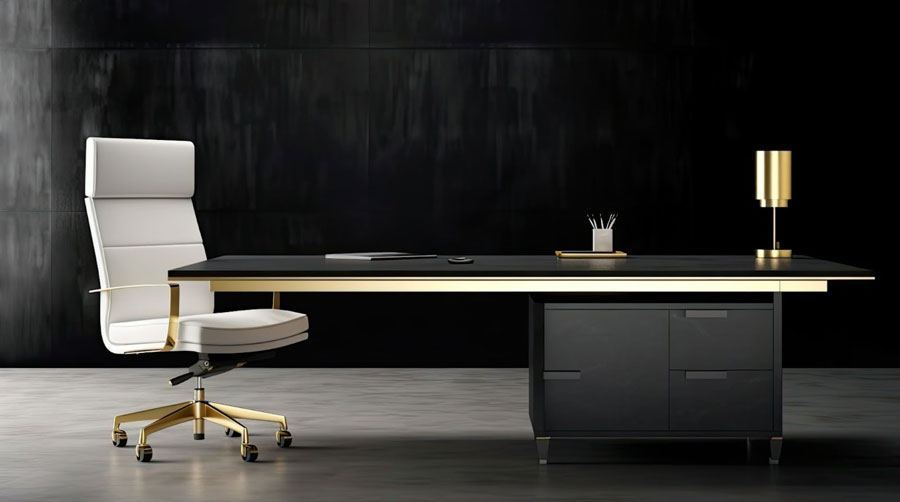The significance of an optimised workspace cannot be overstated.
The choice of an executive desk is much more than a mere aesthetic decision; it’s a strategic move that can enhance your productivity and efficiency in the workspace.
This article delves into the connection between executive desks and productivity, from the influence of layout and furniture to the practical running of day-to-day business.
Connection Between Executive Desks and Productivity
Workspace design plays a crucial role in shaping our productivity and efficiency at work.
The layout, furniture, and overall ambience of an office can significantly impact how we perform our daily tasks.
A well-organised and thoughtfully arranged workspace can lead to increased focus, reduced stress, and higher productivity levels. The right executive desk contributes to this by providing a spacious, organised, and aesthetically pleasing focal point in the office.
Evaluating Your Workspace Needs
Key factors such as desk size, shape, and placement directly affect how we interact with our workspace.
Space and Layout Constraints
Having a desk that is either too small or too large can have negative impacts on your work productivity. A small desk can lead to clutter and disorganisation, which can be distracting and hinder your efficiency. On the other hand, a desk that is too large for the available space can make your office feel cramped and restrict your movement.
To achieve the ideal workspace, an executive desk should find a balance between the two, offering ample space for work essentials while fitting harmoniously into your office environment.
Types of Executive Desks
The executive desk comes in various styles, each offering its unique aesthetic and functional appeal.
The Traditional Executive Desk:
These desks are characterised by their classic and often ornate design elements.
The traditional executive desk is typically made from solid woods such as cherry, mahogany, or oak and feature-rich finishes that exude elegance and timelessness. They often incorporate details like panelling, crown moulding, and brass hardware, making them a popular choice for formal business settings or offices with a classic décor theme.
Traditional Executive Desks are ideal for executives who appreciate the craftsmanship and the grandeur of old-world charm.
The Contemporary Executive Desk:
Contemporary desks are known for their sleek, minimalist designs.
The contemporary executive desk often utilises modern materials like metal, glass, or engineered wood and comes in a variety of finishes, including white, black, or natural wood tones. These desks are designed with simplicity and functionality in mind, featuring clean lines and a more streamlined appearance.
Contemporary executive desks often appeal to executives who value innovation, simplicity, and a forward-thinking approach to office design.
Build A Desk
Think of this as your opportunity to design your dream executive desk; where would you start?
1. Material Matters
Wooden desks are classic and versatile, offering a range of styles from traditional to modern. They are known for their durability and timelessness. However, wood can be susceptible to scratches, requires regular maintenance, and can be expensive.
Metal desks are known for their strength and modern aesthetic. They are also typically more affordable and offer a sleek, industrial look. However, they can be prone to dents and may not provide the warmth and classic appeal of wooden desks.
Glass desks offer a contemporary and minimalist look. They can make a space feel more open and are easy to clean. However, they are prone to fingerprints and smudges, can be fragile, and offer less storage capacity than wood or metal desks.
2. Comfort and Workspace Compatibility
Ergonomic design is crucial in an executive desk to promote comfort and prevent strain during long working hours. Features like adjustable height and adequate legroom can make a significant difference in maintaining a healthy posture and enhancing work efficiency.
The ideal desk height typically ranges between 70 to 75 centimetres. The desk should be wide enough to accommodate necessary equipment and provide ample workspace, typically around 120 to 180 centimetres, in some cases 2 metres wide. The depth should be sufficient for comfortable reach and to place a monitor at a safe distance, usually around 60 to 90 centimetres.
3. Organisational Features
Built-in storage, such as drawers, shelves, and cabinets, can help keep the desk organised and clutter-free. These features should be designed for easy accessibility and to accommodate specific storage needs, like files, office supplies, and personal items.
A clutter-free desk promotes a focused and efficient work environment. Features like cable management systems, under-desk storage, and integrated organisational compartments can help maintain a tidy and productive workspace.
4. Technologically-Friendly
In addition to effective cable management and maintaining a neat workspace, desks that accommodate technology allow for a hazard-free workspace. These desks have built-in cable trays, grommets, and cord holes that allow for organised and discreet routing of wires.
Modern executive desks often include built-in technology features such as integrated power outlets, USB ports, and wireless charging pads.
All of these features can significantly enhance productivity and convenience.
Office Group, Helping You Make the Right Choice
There is a lot to consider when it comes to choosing the right executive desk.
From style to durability to comfort and compatibility in your workspace, it is essential that the desk adds to your overall productivity.
At Office Group, we don’t want your executive desk to be just a piece of furniture but more a testament to your commitment to excellence, a tool that shapes your daily success.
